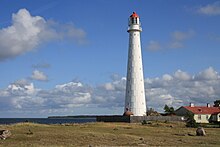Tahkuna
Coordinates: 59 ° 5 ' N , 22 ° 36' E
Tahkuna (German Tachkona , Swedish Taknenäset ) is a village ( Estonian küla ) in the rural community Hiiumaa (2013 to 2017: rural community Hiiu , before that rural community Kõrgessaare ) on the second largest Estonian island Hiiumaa (German Dagö ).
Description and history
The village of Tahkuna is located on the northern tip of the peninsula of the same name ( Tahkuna poolsaar ). The place is fifteen kilometers northwest of the island's capital Kärdla ( Kertel ).
The place was first mentioned in 1564 under the name Thakamaby . Around 1600 he was called Tackenem .
Tahkuna today only 2 residents (as of December 13, 2011). In earlier times the settlement was mainly inhabited by fishermen who also performed pilotage services. The historic seaman's chapel is no longer preserved.
lighthouse
Tahkuna is best known for its lighthouse . The Russian government acquired it at the World Exhibition in Paris in 1871 .
The tower made of prefabricated, cast-iron parts was built in France in 1873/74 and erected a year later in Tahkuna. At 42.7 m above sea level, it is the tallest tower on the Estonian coastline. Its light beam can be seen up to 18 nautical miles .
At the lighthouse there is a stone labyrinth from the most recent times. It was built in 1997 in memory of an earlier maze that is said to have been on the site.
Military installations
The place with its wide view over the Gulf of Finland has been a strategically important observation point since the tsarist times. During the First World War , a port was built in Lehtma , which was connected to Tahkuna by a narrow-gauge railway . In addition, a battery with four 305-mm guns of the type M1907 was built near the cape as part of the expansion of the sea fortress of Emperor Peter the Great . The Russian fortifications were later expanded and captured by the Germans during Operation Albion in 1917. From October 1939, as a result of the German-Soviet non-aggression pact and the addition of independent Latvia to the Soviet zone of influence, the Soviet armed forces set up a combat battery with four 130 mm guns.
During the Second World War , bitter fighting between the Red Army and the German Wehrmacht took place near Tahkuna in October 1941 . A memorial at the foot of the lighthouse commemorates them.
Monument to the victims of Estonia
Behind the lighthouse there is a monument by the Estonian sculptor Mati Karmin directly on the Baltic Sea . It commemorates the children who died when the Estonia sank on September 28, 1994.
The monument depicts a bronze bell attached to a pendulum that is rung by the strong wind. The monument was inaugurated on November 1, 1995 ( All Souls' Day ).
Tahkuna Nature Reserve
The Tahkuna nature reserve ( Tahkuna looduskaitseala ) extends south of the village . It has an area of 1,868.7 hectares.
The extensive forest area with numerous dunes on the Baltic Sea coast is accessible to visitors on signposted paths. The main purpose of the area is to protect the yew tree . It offers nesting opportunities for white-tailed eagles and spotted moorhens .
literature
- Baltic historical local dictionary. Part 1: Estonia (including Northern Livonia). Started by Hans Feldmann . Published by Heinz von zur Mühlen . Edited by Gertrud Westermann . Cologne, Vienna 1985 (= sources and studies on Baltic history. Volume 8/1), ISBN 3-412-07183-8 , p. 573.
Web links
- Description of the place (Estonian)
- Lighthouse and surroundings of Tahkuna (German)
- Pictures of the former military installations
- Description of the former army fortresses (Estonian)
Individual evidence
- ↑ http://www.visitestonia.com/de/leuchtturm-tahkuna
- ↑ Indrek Rohtmets: Kultuurilooline Eestimaa. Tallinn 2004, ISBN 9985-3-0882-4 , pp. 17f.
- ↑ http://entsyklopeedia.ee/artikkel/tahkuna_looduskaitseala



